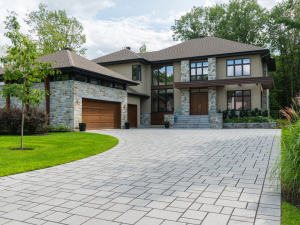Get the week's most popular posts delivered to your inbox.
Our weekly update is free yet priceless and you're less than a minute away from getting the current edition.
In the unlikely event we disappoint, you can unsubscribe with a single click!
Last Updated on December 2, 2025 by teamobn
In competitive housing markets across the United States and Canada, sellers increasingly rely on real-estate agents for more than pricing strategy and negotiation. They seek advice on home improvements that enhance value and attract buyers. The right upgrades can reduce time on the market and justify higher listing prices.
This guide helps real-estate agents identify cost-effective, high-return renovations that make homes stand out in both urban and suburban markets.
Contents
- 0.1 1. Kitchen Improvements that Influence Buyer Decisions
- 0.2 2. Curb Appeal and Exterior Enhancements
- 0.3 3. Energy Efficiency and Smart Technology
- 0.4 4. Bathroom Upgrades That Deliver Strong ROI
- 0.5 5. Flooring and Interior Modernization
- 0.6 6. Functional Additions and Flex Spaces
- 0.7 7. Strategic Guidance for Real-Estate Agents
- 1 Q&A’s on Home Upgrades
1. Kitchen Improvements that Influence Buyer Decisions
Kitchens remain the heart of the home and a decisive factor for buyers. According to Remodeling Magazine’s 2024 Cost vs. Value Report, a minor kitchen remodel recoups an average of 85–90% of its cost upon resale, while a major renovation returns around 65%. Agents advising clients should focus on small but meaningful improvements, such as:
- Refacing cabinets rather than full replacement to modernize aesthetics at a lower cost.
- Upgrading appliances to energy-efficient stainless-steel models, which appeal to eco-conscious buyers.
- Installing quartz or granite countertops for durability and visual impact.
- Improving lighting with under-cabinet fixtures and neutral tones to enhance space perception.
Sellers should avoid over-personalizing finishes, as timeless designs appeal to the broadest audience. Agents can also emphasize that efficiency and layout matter more than luxury materials.
In many regions, homeowners rely on a local expert real estate agent for buying or selling a home to recommend contractors or provide market-specific advice on which upgrades yield the best return.
2. Curb Appeal and Exterior Enhancements
First impressions heavily influence buyer perception. The National Association of Realtors (NAR) reports that homes with improved curb appeal sell 7–14% faster and often above asking price. Agents should encourage sellers to view the exterior as part of the property’s value proposition.
Effective exterior upgrades include:
- Landscaping: Trimmed lawns, fresh mulch, and native plants reduce maintenance and improve presentation.
- Front door replacement: A steel or fibreglass door offers security and style, with ROI often exceeding 90%.
- Exterior paint and siding: Fresh paint signals upkeep; fibre-cement siding delivers longevity and aesthetic appeal.
- Garage doors and walkways: Clean, updated features indicate attention to detail and structural care.
In Canada, weather-resistant materials like composite decking or vinyl siding can prevent long-term damage. In the U.S., particularly in warmer climates, reflective roofing materials enhance energy efficiency, an increasing buyer concern.
3. Energy Efficiency and Smart Technology

Buyers now weigh sustainability alongside comfort and design. Energy-efficient homes lower operating costs and appeal to modern lifestyles. For sellers, small investments in efficiency can position a property as forward-thinking.
Recommended upgrades include:
- Smart thermostats that adjust automatically and integrate with mobile apps.
- Energy Star–rated windows and doors that cut heating and cooling costs.
- LED lighting systems with dimmer controls to improve energy management.
- Insulation improvements in attics or basements to prevent heat loss in cold climates.
For agents, showcasing these upgrades during marketing adds tangible value. Highlighting annual savings can convert interest into offers. For instance, the U.S. Department of Energy estimates that proper insulation can reduce heating bills by 15% or more. In Canada, homeowners may also qualify for provincial rebates, such as Ontario’s Home Efficiency Rebate Plus program.
Smart home features, video doorbells, keyless entry, and intelligent lighting further differentiate listings. They project safety, convenience, and modernity, all of which attract tech-savvy buyers.
4. Bathroom Upgrades That Deliver Strong ROI
Bathrooms are second only to kitchens in influencing purchase decisions. A midrange bathroom remodel can deliver returns between 60–70%, depending on the market. Agents should encourage sellers to focus on functionality, cleanliness, and universal design rather than extravagant finishes.
Effective upgrades include:
- Replacing outdated fixtures with brushed nickel or matte black finishes.
- Adding double vanities or extra storage to improve usability.
- Updating tile work with neutral or large-format tiles to create a clean, modern look.
- Improving lighting and ventilation, both common buyer concerns.
For older homes, minor upgrades like reglazing a bathtub or replacing grout can dramatically improve appeal at minimal cost. Real estate agents can use comparative listings to help sellers determine which bathroom features are standard for their neighbourhood and price range.
5. Flooring and Interior Modernization
Flooring plays a subtle but powerful role in perceived value. According to HomeLight’s 2023 Top Agent Insights Report, refinished hardwood floors offer up to 147% ROI, while installing new hardwood typically returns 118%.
Agents should guide sellers toward durable, low-maintenance materials:
- Hardwood or engineered wood for main living areas.
- Luxury vinyl plank (LVP) or tile for moisture-prone spaces.
- Consistent flooring throughout to create visual flow.
Interior paint also provides a high-value, low-cost refresh. Neutral tones like soft greys, off-whites, or light taupe make rooms appear larger and move-in ready. In both Canadian and U.S. markets, freshly painted interiors can add perceived value even when structural upgrades are minimal.
6. Functional Additions and Flex Spaces
Post-pandemic home-buying trends show sustained interest in flexible spaces, home offices, fitness areas, or finished basements. These features meet lifestyle demands while adding usable square footage.
Agents should recommend cost-effective improvements that define these zones without major construction:
- Add built-in shelving or sliding partitions for adaptable layouts.
- Finish basements with moisture-resistant materials.
- Highlight multi-purpose rooms during staging to show potential uses.
In urban U.S. markets, compact work-from-home setups attract young professionals. In Canadian suburbs, secondary suites or in-law apartments offer rental potential, boosting property appeal and resale value.
7. Strategic Guidance for Real-Estate Agents

Advising clients on upgrades requires balancing cost, local trends, and buyer psychology. Agents should:
- Use data-driven insights from regional MLS reports to identify what features command premiums.
- Evaluate market timing; small improvements may deliver better ROI in a hot market, while larger renovations suit slower cycles.
- Collaborate with contractors to provide cost estimates and realistic timelines.
- Leverage staging and photography to highlight completed improvements in listings.
A consultative approach helps agents strengthen trust and differentiate their expertise. Rather than recommending every possible renovation, focusing on measurable value reinforces the agent’s role as an advisor rather than a salesperson.
For real estate agents guiding sellers, smart upgrades are a strategic tool to improve property value and attract qualified buyers. Kitchens, bathrooms, curb appeal, and energy efficiency consistently deliver the strongest returns across North American markets.
By combining market insight with practical renovation advice, agents position themselves as essential partners in the selling process. The goal is not to overspend, but to invest wisely in changes that yield visible, financial, and emotional returns.
Here are 5 relevant Questions and Answers based on the provided content:
Q&A’s on Home Upgrades
Q: What types of kitchen improvements are recommended for sellers looking for a high return on investment (ROI)?
A: Sellers should focus on small but meaningful improvements as a minor kitchen remodel recoups an average of 85–90% of its cost upon resale, which is significantly better than the roughly 65% return from a major renovation. Key upgrades include:
- Refacing cabinets instead of full replacement for a lower-cost modernization.
- Upgrading to energy-efficient stainless-steel appliances.
- Installing durable, high-impact quartz or granite countertops.
- Improving lighting with under-cabinet fixtures and neutral tones.
Q: Why is curb appeal important, and what are some effective exterior upgrades?
A: First impressions from a home’s exterior heavily influence a buyer’s perception. The National Association of Realtors (NAR) reports that homes with improved curb appeal sell 7–14% faster and often above the asking price. Effective exterior enhancements include:
- Landscaping (trimmed lawns, fresh mulch, native plants).
- Front door replacement with steel or fibreglass, which can have an ROI exceeding 90%.
- Fresh exterior paint and siding.
- Clean, updated garage doors and walkways.
Q: Which flooring upgrades provide the strongest return on investment for sellers?
A: Refinished hardwood floors offer an impressive ROI of up to 147%, while installing new hardwood typically returns 118%. Agents should guide sellers toward using:
- Hardwood or engineered wood for main living areas.
- Luxury vinyl plank (LVP) or tile for moisture-prone spaces.
- Consistent flooring throughout the home to create visual flow. Additionally, applying neutral-toned interior paint (soft greys, off-whites) provides a high-value, low-cost refresh that increases perceived value.
Q: What energy efficiency and smart technology upgrades are recommended to attract modern buyers?
A: Buyers prioritize sustainability and lower operating costs, making energy-efficient homes highly appealing. Recommended upgrades include:
- Installing smart thermostats that integrate with mobile apps.
- Using Energy Star–rated windows and doors to cut heating and cooling costs.
- Switching to LED lighting systems with dimmer controls.
- Improving insulation in attics or basements to prevent heat loss, which can reduce heating bills by 15% or more. Smart home features like video doorbells and keyless entry also attract tech-savvy buyers by projecting safety and convenience.
Q: What strategic steps should real-estate agents take when advising clients on home upgrades?
A: Real estate agents must balance cost, local trends, and buyer psychology. Their strategy should include:
- Using data-driven insights from regional MLS reports to see which features command premiums.
- Evaluating market timing, as small improvements suit hot markets and larger renovations suit slower cycles.
- Collaborating with contractors to provide realistic cost estimates and timelines.
- Leveraging staging and photography to highlight improvements in listings. The goal is to focus on measurable value and invest wisely, not to overspend.
Get the week's most popular posts delivered to your inbox.
Our weekly update is free yet priceless and you're less than a minute away from getting the current edition.
In the unlikely event we disappoint, you can unsubscribe with a single click!






